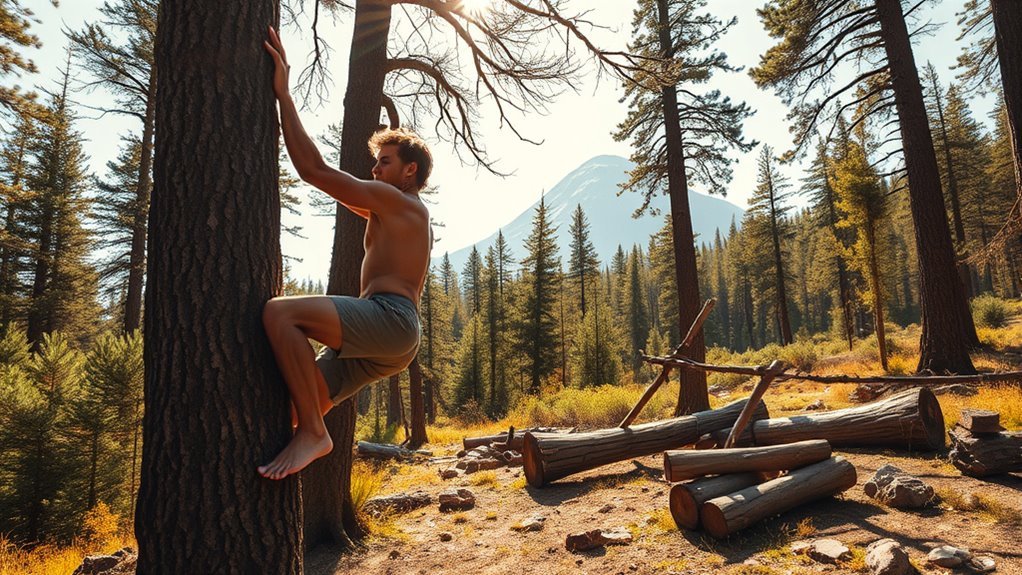The best wilderness survival workouts focus on building endurance, strength, agility, and mental resilience. Incorporate cardio exercises like running and hiking to boost your stamina. Strength training with compound movements, agility drills for quick reactions, and core stability workouts will enhance your balance. Don't forget flexibility and mobility to prevent injuries. Ultimately, cultivating mental resilience through mindfulness and visualization boosts your confidence in the wild. Keep going to discover more about each aspect of survival fitness.
Building Endurance Through Cardio Workouts
While you might think of cardio workouts as just a way to break a sweat, they're crucial for building endurance in wilderness survival situations. When you find yourself maneuvering through rugged terrain or sprinting to safety, having a strong cardiovascular base can make all the difference. Regular cardio training boosts your heart and lung capacity, which means you'll tire less quickly and be able to sustain energy over long distances.
Incorporating activities like running, cycling, or hiking into your routine not only enhances your physical stamina but also sharpens your mental resilience. You'll learn to push through discomfort, a crucial skill when facing unpredictable wilderness challenges. Plus, these workouts can be done anywhere, giving you the freedom to explore the great outdoors while prepping your body for anything Mother Nature throws your way. Embrace the rhythm of your breath and the pulse of your heart; they're your allies in survival. Additionally, consistent mileage builds aerobic capacity, ensuring you can handle extended periods of exertion when it matters most.
Strength Training for Wilderness Survival
Strength training is essential for anyone serious about wilderness survival. It builds the muscle power you'll need to tackle rugged terrains, lift heavy gear, and perform physically demanding tasks. You'll want to focus on compound movements like squats, deadlifts, and push-ups, as they engage multiple muscle groups and improve your overall strength. Incorporating bodyweight exercises is also a fantastic way to build functional strength, allowing you to rely on your own body when you're out in the wild. Consider using resistance bands or finding natural weights like rocks or logs to enhance your workouts. Additionally, exercises like Olympic lifts can significantly improve your explosive strength, which is crucial for quickly navigating challenging environments.
Agility Drills to Enhance Quick Movements
Building strength is just one piece of the puzzle when it comes to wilderness survival; agility plays a critical role as well. Quick movements can be the difference between safety and danger, so incorporating agility drills into your routine is essential.
Here are some effective drills to enhance your agility:
- Ladder Drills: Improve foot speed and coordination using an agility ladder.
- Cone Drills: Set up cones for quick directional changes, mimicking the unpredictability of the wild.
- Jumping Exercises: Work on plyometrics like box jumps to boost explosive power.
- Shuttle Runs: Sprint back and forth to enhance your speed and quickness.
These exercises will help you navigate through rough terrain, dodge obstacles, and respond swiftly in any situation. Embrace the freedom of movement, and you'll be better prepared for whatever wilderness challenges come your way! Incorporating agility ladder drills into your routine can significantly enhance your overall performance and quick decision-making abilities.
Core Stability Exercises for Better Balance
As you navigate through the wilderness, having a strong core can greatly enhance your balance and stability. A solid core helps you maintain control on uneven terrain and keeps you steady during those unexpected movements. To build this strength, incorporate exercises like planks, side planks, and bird-dogs into your routine.
Planks engage your entire core, while side planks target the obliques, essential for lateral stability. Bird-dogs challenge your balance and coordination, mimicking the movements you'll encounter outdoors.
Additionally, strong core muscles help prevent injuries and improve your overall body mechanics, making it essential for wilderness exploration.
Perform each exercise for 30 seconds, resting briefly between sets. Aim for three rounds to really feel the burn. You'll notice improved posture and an increased ability to adapt to the wild around you. With a strong core, you'll feel more grounded and confident, empowering you to explore freely and tackle any wilderness challenge that comes your way. Get ready to embrace your adventurous spirit!
Functional Fitness for Real-World Scenarios
When you're out in the wilderness, having functional fitness can make all the difference in how you handle real-world scenarios. It's not just about lifting weights; it's about preparing your body for unpredictable challenges. By focusing on functional movements, you'll improve your ability to adapt and thrive in nature.
- Climbing over obstacles
- Carrying heavy loads
- Traversing rugged terrain
- Responding quickly to emergencies
These workouts mimic the actions you'll perform in survival situations, enhancing your strength, agility, and endurance. Whether you're scaling a rock face or gathering firewood, being physically prepared empowers you to face the wild with confidence. Embrace the freedom of movement that comes with functional fitness, and you'll find yourself ready for whatever wilderness adventures await. Prioritize these exercises, and you'll discover a newfound resilience that transcends the gym, connecting you deeply to the great outdoors. Additionally, functional strength training enhances core stability and strength, which is crucial for maintaining balance and control in challenging environments.
Outdoor Workouts: Embracing Nature's Gym
When you step outside, nature offers a unique gym filled with opportunities for strength training and endurance building. Whether you're lifting logs or tackling challenging trails, you can transform the great outdoors into your personal workout space. Embracing these natural elements not only boosts your fitness but also connects you more deeply with the environment around you.
Nature-based Strength Training
While many people associate strength training with a gym, embracing nature's gym can offer a revitalizing and invigorating alternative. Imagine harnessing the power of the great outdoors to build strength and endurance. You'll not only get fit but also reconnect with your surroundings. Here are some ways to integrate nature into your strength training:
- Tree Climbing: Build upper body strength by scaling trees.
- Rock Lifting: Use natural boulders for squats and deadlifts.
- Log Carrying: Enhance core strength and stability by hauling logs.
- Trail Sprints: Boost cardiovascular fitness and leg power on uneven terrain.
Get outside, feel the fresh air, and let nature be your workout partner! Freedom awaits in every push, pull, and leap.
Endurance Through Hiking Adventures
Hiking not only offers a chance to explore breathtaking landscapes but also serves as an excellent way to build endurance. As you traverse diverse terrains, your body adapts and strengthens, allowing you to embrace longer adventures. Every incline challenges your legs, while every descent tests your balance, pushing you to grow.
Feel the freedom of the great outdoors as you breathe in fresh air, leaving behind the confines of everyday life. With each step, you're not just hiking; you're forging a deeper connection with nature. Mix in some interval training by varying your pace or tackling steeper trails, and you'll boost your stamina even more. So grab your pack, hit the trails, and let the wilderness be your gym!
Flexibility and Mobility for Injury Prevention
To prevent injuries during wilderness survival workouts, incorporating flexibility and mobility exercises is essential. These practices not only enhance your range of motion but also prepare your body for the unpredictable challenges of the wild. By fostering a free-flowing movement, you'll feel more connected to your surroundings and less prone to strains or sprains. Consider adding these exercises to your routine:
- Dynamic stretches to warm up your muscles
- Yoga poses for balance and stability
- Foam rolling to release muscle tension
- Static stretches to improve overall flexibility
Integrating these elements into your workouts allows you to explore the wilderness without fear. You'll be able to climb, jump, and traverse uneven terrain with confidence, knowing your body is prepared. Additionally, practicing mobility training not only helps in injury prevention but also enhances overall athletic performance. Flexibility and mobility aren't just about injury prevention; they're about embracing the freedom to move fluidly in nature's playground. Your body will thank you!
Mental Resilience: The Psychological Aspect of Survival Fitness
When it comes to survival, your mindset can make all the difference. By mastering stress management techniques and employing visualization and focus, you can strengthen your mental resilience. Mindfulness meditation can also greatly enhance enhanced focus, allowing you to better navigate challenging situations and make quick decisions under pressure.
Mindset Over Matter
Survival fitness demands more than just physical strength; it requires an unyielding mindset that can withstand the harshest challenges. Your mental resilience is key to overcoming obstacles and thriving in the wild. It's not just about muscles; it's about how you think and react when faced with adversity.
- Embrace discomfort as a growth opportunity.
- Visualize success to boost your confidence.
- Stay adaptable; rigidity can lead to failure.
- Cultivate a sense of purpose to fuel your determination.
When you prioritize mindset, you empower yourself to push through barriers and embrace the freedom that comes with mastering survival skills. Ultimately, your mental fortitude will be just as essential as your physical preparedness in the wilderness.
Stress Management Techniques
While challenges in the wild can trigger stress, effective stress management techniques can enhance your mental resilience and overall performance. Start by practicing deep breathing; it grounds you in the moment and eases tension. Embrace mindfulness to stay aware of your surroundings and eliminate distractions. Additionally, physical activity can be a powerful stress reliever—get moving to release endorphins and boost your mood. Connect with nature; it's a reminder of your freedom and strength. Journaling your thoughts can also provide clarity, helping you process emotions. Finally, remember to maintain a positive mindset—focus on what you can control and cultivate gratitude for your experiences. These techniques will empower you to thrive, no matter the wilderness challenges you face.
Visualization and Focus
Mental resilience in the wilderness relies not just on physical fitness but also on your ability to visualize success and maintain focus. When you're out there, it's crucial to harness your mind's power to overcome challenges. Here's how you can sharpen your mental edge:
- Picture yourself maneuvering through tough terrains successfully.
- Stay in the moment, focusing on immediate tasks rather than getting overwhelmed.
- Use positive affirmations to boost your confidence and calm your nerves.
- Regularly practice mindfulness to enhance your awareness and decision-making.
Frequently Asked Questions
What Equipment Is Needed for Wilderness Survival Workouts?
For wilderness survival workouts, you'll need sturdy footwear, a durable backpack, water bottles, a multi-tool, first aid supplies, a compass, and weather-appropriate clothing. These essentials help you thrive in any outdoor training environment.
How Often Should I Train for Wilderness Survival?
You might think training for wilderness survival is just a weekend thing, but it's not! Aim for at least three times a week. Consistent practice keeps you sharp and ready for any adventure that comes your way.
Can I Do These Workouts at Home?
Absolutely, you can do these workouts at home! With minimal equipment, you'll build strength and endurance. Just make sure to create a space that challenges you, letting your spirit of adventure thrive in your own environment.
What Is the Best Diet for Wilderness Survival Training?
For wilderness survival training, focus on whole foods—lean proteins, fruits, vegetables, and healthy fats. You'll want to stay hydrated too. These choices fuel your body, keeping you energized and ready for any outdoor challenge.
How Do I Track My Progress in Survival Fitness?
You're not a lone wolf howling at the moon, right? To track your survival fitness, jot down your feats, like tree-climbing triumphs or fire-starting finesse. Celebrate each little victory while embracing that wild spirit within!




